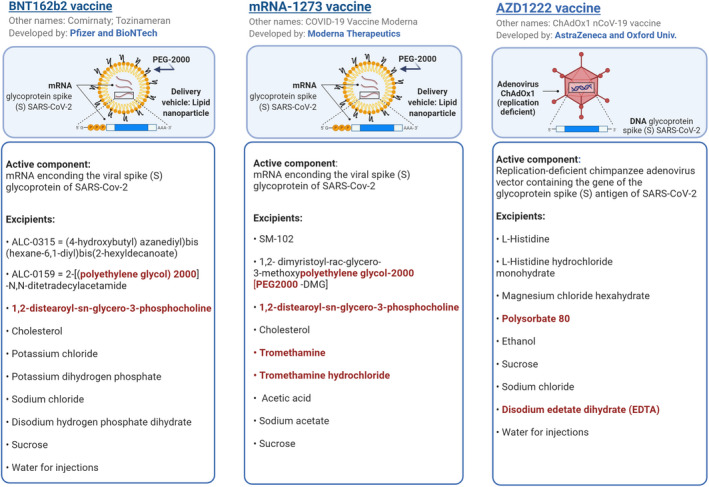To the Editor,
Thank you for the correspondence of Borgsteede et al “Other excipients than PEG might cause serious hypersensitivity reactions in COVID‐19 vaccines.”1
We agree with the authors and their observations indicating that other components different from polyethylene glycol (PEG) in the currently available COVID‐19 vaccines could also have a potential role in the recently described hypersensitivity reactions after vaccines administration. In our editorial, we focused on BNT162b2 vaccine developed by BioNTech and Pfizer given special attention to the excipient PEG 2000 g/mol (PEG‐2000) contained in the vaccine in form of a PEGylated micellar carrier as a potential culprit of the reported anaphylactic reactions. As an excipient of BNT162b2, PEG‐2000 may most likely produce an allergic response2. As allergic reactions to other vaccines were not reported at that time, we focused on the first developed COVID‐19 vaccine, and our editorial did not cover other COVID‐19 vaccines. In that regard, we have recently pointed out in a follow‐up article that the excipient tromethamine (also named trometamol) contained in the Moderna mRNA‐1273 vaccine could play a role in anaphylactic reactions in sensitized individuals as well.3 As Borgsteede et al1 and ourselves3 indicated, a recent article has reported the first case of anaphylaxis to trometamol as an ingredient in a gadolinium‐based radio contrast agent (GBCA). The reaction was induced shortly after the injection of GBCA and an IgE‐mediated mechanism against trometamol could be detected.4 Although both BNT162b2 and mRNA‐1273 vaccines are mRNA vaccines containing PEG‐2000, the excipient tromethamine can only be found in the latter (Figure 1).
FIGURE 1.

Active components and excipients listed in BNT162b2, mRNA‐1273, and AZD1222 vaccines. The principles of the PEGylated‐lipid nanoparticles as a delivery system for the mRNA in BNT162b2, mRNA‐1273 vaccines are depicted in the upper part together to the replication‐deficient adenovirus ChAdOx1 vector containing the gene of the glycoprotein spike (S) antigen of SARS‐CoV‐2 for the AZD1222 vaccine. Potential triggers of allergic reactions are indicated in red color in the excipient lists of each vaccine
The third vaccine for the prevention of COVID‐19 has been recently approved in the United Kingdom. The vaccine, named AZD1222, developed by Oxford University and AstraZeneca, consists of a replication‐deficient chimpanzee adenovirus (ChAdOx1) vector that contains the gene of the glycoprotein spike (S) antigen of SARS‐CoV‐2. Although the AZD1222 DNA vaccine does not contain PEG‐2000 or other PEGs with different molecular weights, as Borgsteede et al pointed out,1 it does contain the structurally related compound polyoxyethylene‐80‐sorbitan monooleate or polysorbate 80 (also named Tween 80) (Figure 1). The cross‐reactivity between polysorbate 80 and PEGs seems to be due to a shared moiety –(CH2CH2O)n contained in both compounds. Polysorbate 80 is widely used as an emulsifier and stabilizer in the food industry and it is also a common excipient in medications and vaccines such as influenza, hepatitis B, human papillomavirus (HPV) vaccines, with the function of facilitating the vaccine components to stay soluble. Polysorbates 20, 40, and 60 also exist. Polysorbates 80 and 20 have also been included as excipients in other SARS‐CoV‐2 vaccines currently under evaluation in phases I, II, or III trials and that are based on adenovirus vectors or on the recombinant glycoprotein (S) spike antigen.5 Up to date, most of the cases of allergic reactions to polysorbates have been associated with medicines containing this excipient and only a few cases of allergy to vaccines due to polysorbates have been reported.6, 7 The cases could be underrepresented due to the general unawareness among physicians of the allergenic potential of excipients such as polysorbates that may be behind an unclear allergic reaction to a given vaccine.
The role of other vaccines components such as 1,2‐distearoyl‐sn‐glycero‐3‐phosphocholine (DSPC) or EDTA as potential triggers of hypersensitivity reactions should also be considered (Figure 1).
Although in general terms allergic reactions to vaccines are rare, the fact that the newly developed vaccines for the prevention of COVID‐19 will be applied to a considerable majority of the world population makes it important for healthcare providers to be aware of the potential threat of the excipients from COVID‐19 vaccines with the potential to produce hypersensitivity reactions before the administration of the vaccines.
CONFLICT OF INTEREST
CA reports grants from Allergopharma, Idorsia, Swiss National Science Foundation, Christine Kühne‐Center for Allergy Research and Education, European Commission Horizon 2020 Framework Programme, Cure, Novartis Research Institutes, AstraZeneca, SciBase, advisory role for Sanofi/Regeneron, GlaxoSmithKline, SciBase, and Novartis, outside the submitted work. NN and BC declare no conflicts of interest.
REFERENCES
- 1.Borgsteede S, Geersing TH, Tempels‐Pavlica Z. Other excipients than PEG might cause serious hypersensitivity reactions in COVID‐19 vaccines. Allergy 2021;76(6):1941‐1942. [DOI] [PMC free article] [PubMed] [Google Scholar]
- 2.Cabanillas B, Akdis C, Novak N. Allergic reactions to the first COVID‐19 vaccine: a potential role for polyethylene glycol?. Allergy 2021;76(6):1617‐1618. [DOI] [PubMed] [Google Scholar]
- 3.Klimek L, Novak N, Cabanillas B, et al. Allergenic components of the mRNA‐1273 vaccine for COVID‐19: possible involvement of polyethylene glycol and IgG‐mediated complement activation. Allergy 2021. 10.1111/all.14794 [DOI] [PMC free article] [PubMed] [Google Scholar]
- 4.Lukawska J, Mandaliya D, Chan AWE, et al. Anaphylaxis to trometamol excipient in gadolinium‐based contrast agents for clinical imaging. J Allergy Clin Immunol Pract. 2019;7(3):1086‐1087. [DOI] [PubMed] [Google Scholar]
- 5.Castells MC, Phillips EJ. Maintaining safety with SARS‐CoV‐2 vaccines. N Engl J Med. 2020; 10.1056/NEJMra2035343 [DOI] [PMC free article] [PubMed] [Google Scholar]
- 6.Badiu I, Geuna M, Heffler E, Rolla G. Hypersensitivity reaction to human papillomavirus vaccine due to polysorbate 80. BMJ Case Rep. 2012; 10.1136/bcr.02.2012.5797 [DOI] [PMC free article] [PubMed] [Google Scholar]
- 7.Stone CA Jr, Liu Y, Relling MV, et al. Immediate hypersensitivity to polyethylene glycols and polysorbates: more common than we have recognized. J Allergy Clin Immunol Pract. 2019;7(5):1533‐1540.e8. 10.1016/j.jaip.2018.12.003 [DOI] [PMC free article] [PubMed] [Google Scholar]


